In this paper, we explore the use of neural networks to forecast the spread of infectious diseases. Our approach combines two types of graphs – the backbone graph and the temporal graph – to represent the relationships between individuals and the progression of the disease over time. We investigate different fusion methods to generate dynamic graphs with enhanced expressive power, and conduct research on integrating epidemiological knowledge into neural networks to improve their accuracy without increasing training time.
Methodology
Our method involves simulating the spread of infectious diseases using a neural network model. We use the backbone graph to represent the connections between individuals in a population, and the temporal graph to capture the progression of the disease over time. We experiment with different fusion methods to generate dynamic graphs that can better capture the complex relationships between individuals and the disease.
Modeling
We use a transformer-based architecture to model the dynamics of the disease spread. The transformer is a type of neural network that is particularly well-suited for sequential data, such as time series data. We also explore the use of attention mechanisms to focus on specific parts of the input data that are most relevant to the disease spread.
Validation
We validate our model using real-world data from cities in China and Japan. We compare the performance of our model with other state-of-the-art models, and show that it outperforms them in terms of accuracy. We also conduct a series of ablation studies to demonstrate the effectiveness of different components of our model.
Conclusion
In this paper, we propose a novel approach to forecasting the spread of infectious diseases using neural networks. Our method combines two types of graphs – the backbone graph and the temporal graph – to represent the relationships between individuals and the progression of the disease over time. We also investigate different fusion methods to generate dynamic graphs with enhanced expressive power, and conduct research on integrating epidemiological knowledge into neural networks to improve their accuracy without increasing training time. Our results demonstrate the effectiveness of our approach in accurately forecasting the spread of infectious diseases, and its potential for use in real-world applications such as public health policy making.



